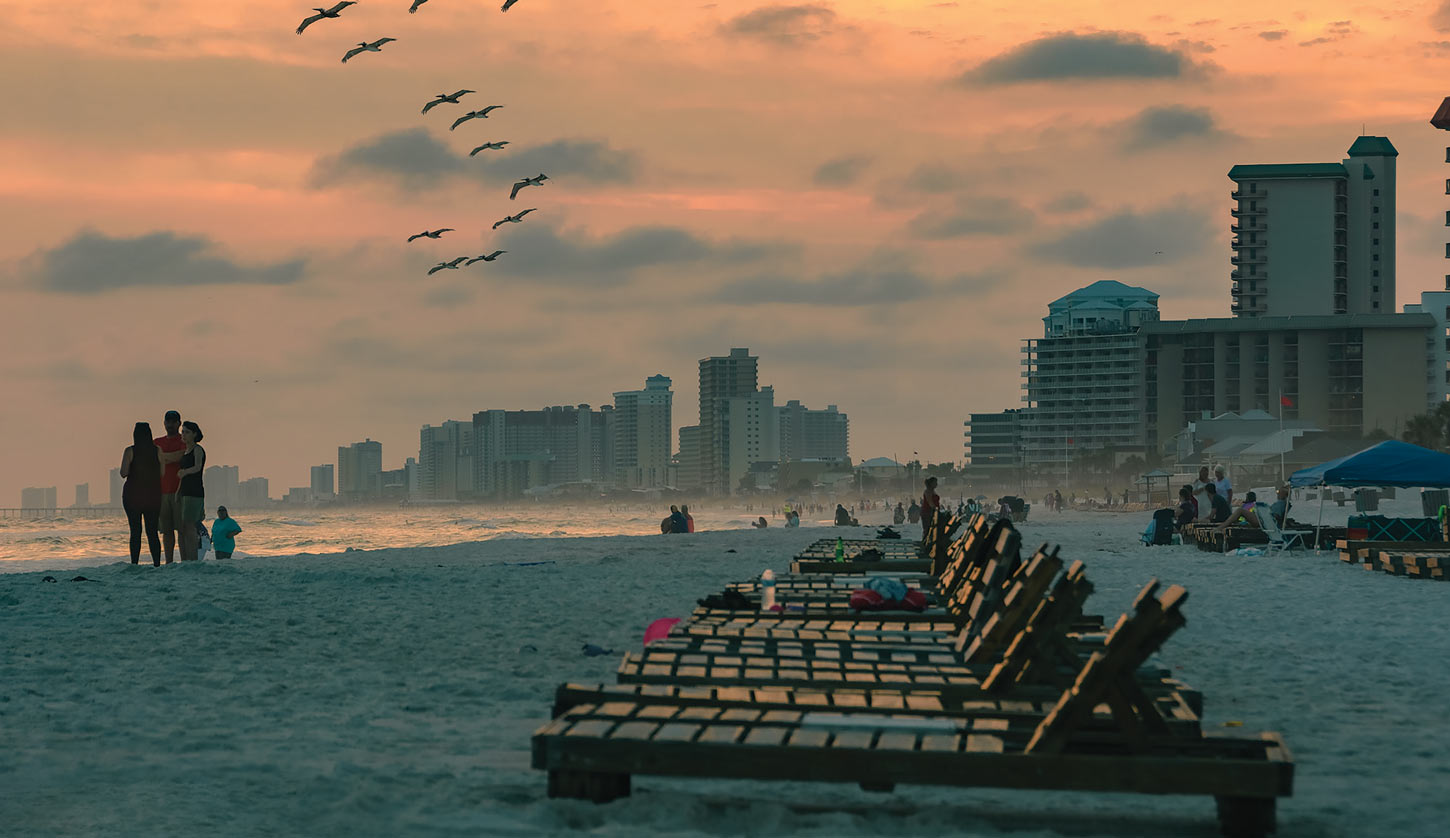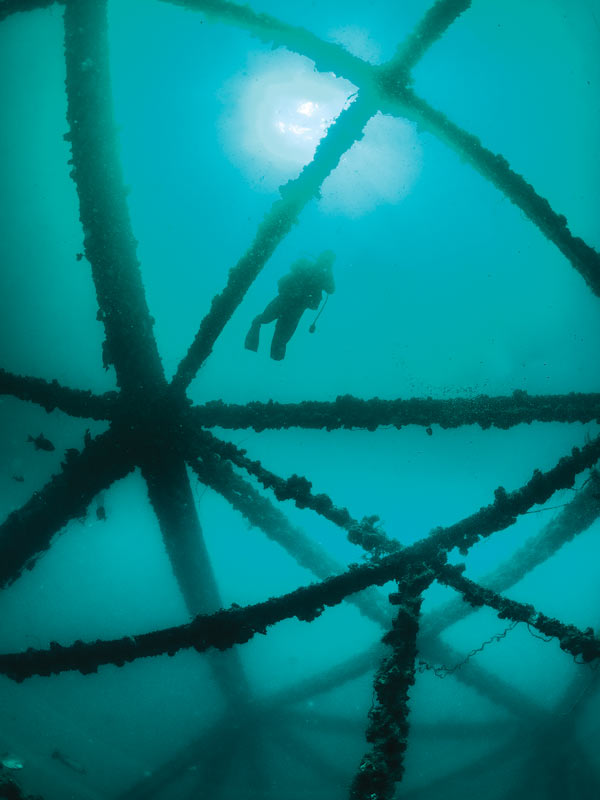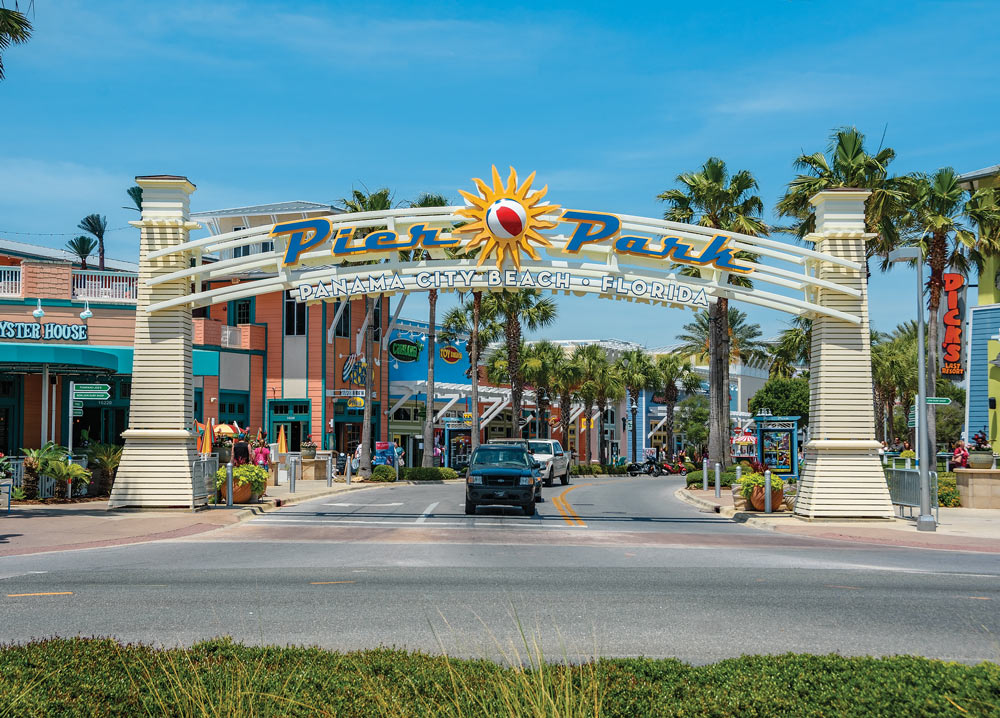THE NORTHWESTERN FLORIDA PANHANDLE community of Panama City Beach (PCB) is small but mighty, filled with exhilarating activities and entertainment that will fulfill the wishes of water sports enthusiasts, golfers, hikers, scuba divers and more. Folks living here have a special sense of hometown pride — and they’re happy to brag about it to visitors. They’re quick to tell you this jewel of the Gulf of Mexico is lovingly known as the Emerald Coast and they’ll point to signs illustrating the city’s slogan, “The World’s Most Beautiful Beaches.” Even without the signs or the bragging, it’s easy to recognize PCB’s beauty all by yourself.
Panama City Beach: Thriving for Thousands
It seems this area of the Florida Panhandle has thrived for thousands of years. Archaeological research indicates early settlers made good use of the region’s natural resources and abundant marine life. Indian mounds, village sites and heaps of shells were also uncovered, giving further proof of the presence of ancient man. By the 1500s, Spanish, French and British sailors also explored the area but did not build any lasting settlements. Eventually, the Spanish built forts in the panhandle near the Mexican Beach area. Pirates and privateers also sailed the seas around Florida using bays to hide in, always on the lookout to plunder passing boats filled with treasures.
During the American Revolution, the loyalists-built Panama City. Indigo, a plant that yields blue dye, was one of the most valuable cash crops of the era. Lumber, salt production and naval stores were also profitable endeavors for the loyalists. During the Civil War, Union soldiers leveled the village to destroy the salt works desperately needed by Southern soldiers.
Panama City was rebuilt and formally incorporated in 1909. On May 2, 1936, PCB was incorporated in Bay County. Keep in mind that PCB, which is a barrier island separated from the mainland by St. Andrews Bay, is not the same as Panama City. In 1929, St. Andrews Bay Bridge was built to connect PCB to the mainland, opening up the possibility of tourism. In 2000, many of the smaller homes on the beach were replaced by large hotels and resorts that now dominate most of the eastern beachfronts. The rest is history, with over 17 million visitors coming to PCB every year.

Beaches here get even more beautiful at sunset. Photo by Ruth and Barry Guimbellot.
Southern Hospitality
Visitors who flock to PCB every year will find the locals friendly and welcoming, with just the right touch of southern charm. Locals may be small in numbers, but they are BIG in hospitality. We find it amazing that the city of approximately 14,000 people can host millions of annual visitors, providing them with so many entertainment options.
Accommodations range from quaint Bed and Breakfast stays to luxurious beachfront hotels. Condos, with all the amenities, are also a great option for families. Singles, groups, families and retirees will be able to find the perfect place to enjoy their stay, whether it’s for a week or a month.
Restaurants along the Emerald Coast range from elegant eateries to casual beach bars and grills. Seafood reigns supreme, with barbecue not far behind. You’ll also find burger joints, Tex-Mex and a wider variety of other dining options.
As each day winds down, the locals take “tiki time” seriously. As the sun sets, the beach comes alive with bands playing music meant for dancing or just chilling. The beach at sunset is also a magical place to ditch your flip-flops and go for a stroll. The sand is so fine it resembles very white powdered sugar, giving it an amazingly soft texture. Once you’ve experienced it for yourself, you’ll appreciate the “best beaches” slogan.
One of the things that struck us about the community pride evident here is how the locals came together after Hurricane Michael hit the region in October 2018. Michael was an unwelcome visitor, for sure, but local residents didn’t waste any time cleaning up. Here we were visiting less than a year later and saw little evidence of the storm. Recovery has been rapid: the beach is beautiful, the streets are in great shape and the city is once again turning on the charm for its visitors.

Bridge span dive sites give divers lots of area to explore. Photo by Ruth and Barry Guimbellot.
Diversity for Divers in Panama City Beach
The diving in Panama City Beach is divided into three categories: inshore, offshore and technical. Inshore diving is closer to the beach with conditions and depths to accommodate novices. Offshore diving sites are chosen to accommodate divers with advanced or higher certifications. Technical dive sites are reserved for divers that have technical training. For those who are cave certified there are several freshwater caves around PCB within gin clear rivers and streams.
The area is known as the Emerald Coast, named so because of the aqua to greenish hues produced by nutrients in the water — nutrients that feed marine life — making this area one of the “fishiest” you will find in the Gulf of Mexico.
Inshore dive sites include the various jetties that are close to shore or one of the barrier islands. Most of the other dive sites in the area consists of either wrecks placed as artificial reefs or bridge spans. Bridge spans are the upper structures of bridges that were in the area and replaced by more advanced bridges.
The bridge spans are an excellent place for divers to explore. They have a lot of surface area, including nooks and crannies that house small marine life like crustaceans, gobies and blennies. Of course, the littles attract the biggers and the biggest and so on. To the delight of spear fishermen and fishermen, schools of different fishes are abundant on these structures.
It should be noted that spearfishing is allowed around Panama City Beach and it is common for spearfishers and recreational scuba divers to share the same boat. Spearfishing is very highly regulated for the safety of divers, though, and boat crews do a great job of ensuring that everyone has a safe, fun experience.
More diverse than the bridge spans are the number of artificial wrecks that divers enjoy. One of the most famous wrecks there is the Black Bart, sunk in 1993. The Black Bart is 185 feet (56 m) long and rests in about 75 feet (23 m) of water. The wheelhouse is now gone but there is plenty else to explore. The wreck is a great location for new divers to explore.
The newest wreck is the 157 feet (48 m) long El Dorado, sunk at its final resting place on May 9, 2019. The wreck was a three-story party barge that now sits in 100 feet (31 m) of water. The El Dorado photo that accompanies this article was taken May 18, 2019. Already the wreck was covered with giant schools of fish that at times obscured view. It was such a joy to see this wreck serving as an artificial reef and providing a gathering spot for so much life. This wreck is sure to be a huge attraction for divers visiting PCB.
With over 50 artificial reefs and hundreds of small limestone reefs, there is no wonder PCB is a major destination for the U.S. Southeast.
Assorted Aquatic Adventures
Exciting adventures are plentiful when it comes to water sports. Kayaking, canoeing and kite surfing offer fun options. Or perhaps standup paddle boarding or skim boarding will intrigue you. Snorkeling is always a fun way to peek below the surface in search of fascinating marine life. If you like a bird’s eye view of the beautiful white-sand beach and emerald-colored water, try parasailing.
The beaches are perfect for skim boarding and surfing. Moderate to small waves are the norm, making it easier for the novice to hone their surfing skills. The conditions are especially conducive to skim boarding which is using a flat board to skim across the shallow water. PCB has produced some of the nation’s best techno skim boarders.
PCB has a safety flag system for beach/water conditions. Please observe the warning system as it is for your own safety. Violators who ignore these warnings risk arrest. There is also a “leave no trace” policy, which states that if you leave personal items on the beach between 7 pm and 7 am, they will be removed and disposed of by authorities.

No visit to PCB would be complete without a shopping excursion to Pier Park. Photo by Ruth and Barry Guimbellot.
Topside Touring and Trekking
Panama City Beach offers visitors a treasure chest overflowing with activities and entertainment. We cannot begin to cover all that is available, but we will do our best to whet your appetite with a few suggestions. Pier Park, Zoo World and St. Andrew State Park are great places to visit. Everyone will enjoy a visit to Pier Park, an excellent shopping and entertaining destination. Fifty shops and dining facilities are part of this open-air center. There is also a large movie complex known as “The Grand 16-Plex Theatre” when you need a break from shopping. The newest addition by Pier Park is the SkyWheel, an entertainment venue opening this summer. Sky-Wheel is an observation wheel almost 200 feet (61 m) tall. The glass-enclosed gondolas also have glass floors, providing a great view of the Pier Park skyline.
If you are a golf enthusiast, you are in the right place. Golf Digest named the PCB area one of “America’s Top Three Golf Towns,” which is a well-earned title. Courses are available for everyone from beginners to pros and miniature golf courses are plentiful for the younger set. Many courses are on or near hotels and often do not require club memberships.
Zoo World is an exciting outing for visitors who enjoy the “wild” side. Everyone enjoys the animals, especially the children. They are able to interact with the animals, feeding and petting baby giraffes, lemurs, sloths and parakeets. There are also daily shows. The nonprofit Zoological and Botanical Conservatory provides educational tours to visitors.
St. Andrew State Park, one of two protected nature preserves, provides an adventure for the whole family. The park covers 1,200 acres and has miles of trails, 25 of which are paved. Activities include hiking, picnicking and cycling. When hiking, it is possible to see alligators, deer and a variety of migratory birds. The newest attraction on the beach is a WWII gun mount covered by sand dunes since the 1940s and “reintroduced” by shifting sands during the hurricane.
A statewide system known as Greenways and Trails, covers the whole PCB area. Econfina Creek, Gayle’s Trails and Pines and Ponds, a 3,000-acre park, represent only a part of the system of nature trails.
A visit to Shell Island gives visitors a chance to enjoy an uninhabited island. Shuttles and pontoons carry people across the St. Andrew Bay to enjoy sunbathing, snorkeling, shelling and kayaking. Playful dolphins are often seen jumping in the wake of the boats, which is always a thrill for passengers.
Not everyone has the great good fortune of being a Panama City Beach local. But don’t be shy about planning a visit, because the residents here are happy to welcome you. Even if you can only stay a short while, you’ll likely leave here feeling the urge to return again soon.





